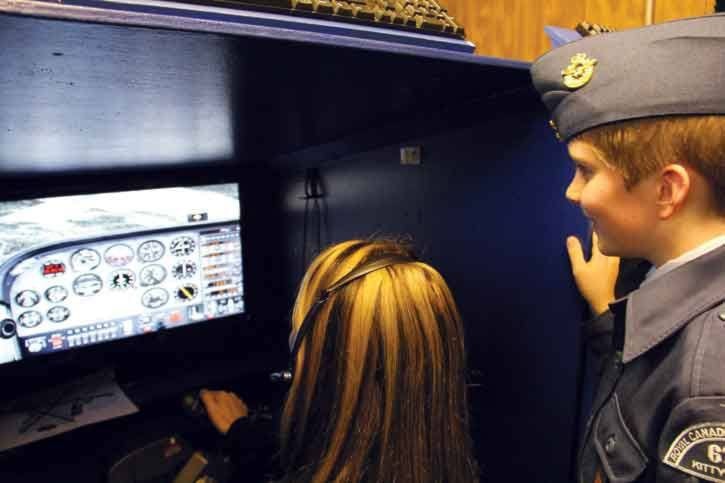Deborah Cracknell grips the control easing it forward.
“Lower,” a voice says into her right ear.
Her son Kane leans forward, tweaks a button or two.
“Keep your nose up.”
She bumps onto the runway at Victoria International Airport stopping just short of the dirt in the distance.
Her 12-year-old son has just guided her through her inaugural flight.
“With the help of my son I didn’t crash land,” she says with a grin. “To me it really seemed realistic.”
Kane congratulates her, adjusts the wedge on his head and leans around the cubicle to see how dad’s doing.
Kane is among the air cadets at 676 Kittyhawk squadron to display their talent and new wares at the official launch of the flying lab at the cadet hall off de Havilland Way near the airport. Six cubicles hold state of the art Microsoft equipment in the air simulator lab for the computerized aircraft simulation centre (CASC) program, after some hard work by the 55 cadets in the local squadron and a $3,500 kick-in from the Victoria Airport Authority.
For decades cadets has been a stepping stone for kids getting their wings, both power and gliding. The $5,700 overhaul of the system at Kittyhawk brings it “as close to reality as we can really get,” says instructor Peter Reynolds. “It puts the air back in air cadets.”
Flt. Cpl. Justin Pond led airport authority CEO Geoff Dickson through his first flight.
“It basically teaches you all you need to know about flying,” says Pond, who aims to become a military cargo pilot.
At 14, Pond is in his third year of the CASC program and is impressed with the upgrade from old software and 10-inch screens.
“The new ones we have in there, with the money donated by the airport authority, has really helped,” the Stelly’s secondary school student says. “Everything is more realistic and runs so much smoother.”
In February they added a tower, so six cadets can fly while one runs things from the other room. It’s the multi-player aspect, as well as more advanced lessons available that appeal to the more experienced cadet.
For Kane Cracknell it’s simply fun still. “It’s fun to fly. It’s interactive and makes it interesting.”
A cadet since September, Kane already sees the benefits of the CASC program for his goal of becoming a commercial pilot.
“I’ve learned how to adjust everything to make flying safe,” he explains.
As Pond leads Dickson through his flight, cadets teach each other in various programs, from CASC to band. They learn leadership, instruction and responsibility.
“Part of our cadet program is teaching the younger cadets,” Reynolds says. “There’s a course in instructional techniques.”
Cracknell’s only been a cadet since September, but already his mom’s seeing growth.
“He found something that he loves, that he’s passionate about,” Deborah says. “I’ve seen him grow up in that little bit of time.”
